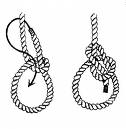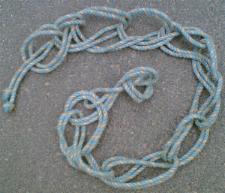AUSTRALIAN CUB SCOUT
GOLD BOOMERANG REQUIREMENTS
Part 3 – Ropes
(Outdoor Scouting)
A RELAY style game makes testing knots much more fun (especially if done as per the Silver level, tying a sling)
| Tying Knots | |
| Tie a reef knot |

|
| Tie a clove hitch |

|
| Tie a sheetbend |

|
| Tie a bowline |

|
| Make a gadget using at least one type of appropriate lashing. |
There are several suitable items that can be made by cubs for this requirement of the Gold Boomerang. |
| Teach another Cub Scout (eg – Bronze or new chum) how to tie a reef knot. |
This can be done either as part of a knots session, or as the lead-up to a knot-tying game – the gold cubs could even go with the bronze as guide them during the tying of their reef knot in the relay game.
|
| Use of Knots | |
| Discuss how and where to use these knots. |
The Reef Knot (or Square Knot) is a binding knot used to tie a rope around something to secure it. It can also be used to tie two identical ropes together, but the MUST be of the same size, material, age, and condition, or the knot WILL slip. For joining two ropes, a sheet bend is superior.
A Clove Hitch is used to tie a rope to a batten or post. It is usually finished with a half-hitch stopper back around the standing line to prevent slippage, as a safety. If you learn only two knots, the bowline is the first, and this is probably the second. The Sheet Bend is used for joining two ropes. It will work with identical ropes or ropes of different sizes, materials, and stiffness. It is less likely to slip than a square knot. The Bowline can be used to tie around your waist when climbing, or in an emergency situation as it can be tied one handed with very little practice, thus leaving your other hand free to still hold on rather than falling. It is also THE prime theatre knot. Tied properly it WILL NOT slip. If you remember only one knot, this is it. It is used to tie a fixed loop in the end of a rope. Riggers use it on a rigging line to send equipment into the air. Electricians use it to send instruments up to the beams on a rope. It can make a non-slip loop around an object, or if tied back around the rope like a lasso, will tighten down on the object. It can even be used to tie two ropes together by putting a bowline in the end of one line, the tying a bowline in the end of the other through the first bowline. This is the best method of adding rope to a spot-line on a "rope" system that is a little short, because it is even more secure than a sheet bend in stiff, heavy ropes.
|
| Care of ropes | |
| Show how to hank or chain a rope correctly. |
Hank
- A looped bundle of cordage. A means of packaging rope or cords by winding it into a series of loops and tying them about the centre. Chain
- A multiple-looped means of storing a rope (usually a thicker one). Fold your rope in half (or quarters) then create a loop in the end that has the "middle" (ie. NOT with the 2 loose ends if quartered) using a loosely tied double-overhand knot or by twisting it near that end. Then create a bight from the next bit of rope, and pass it loosely through the loop, and repeat this process until you reach the end of the rope. Finally the loose end(s) are tucked through the final loop/bight. The result looks like a chain made of rope.
|
© 2008 Ian Moggs - rights are given for copying and printing for personal use or use in cub-scout or similar groups.